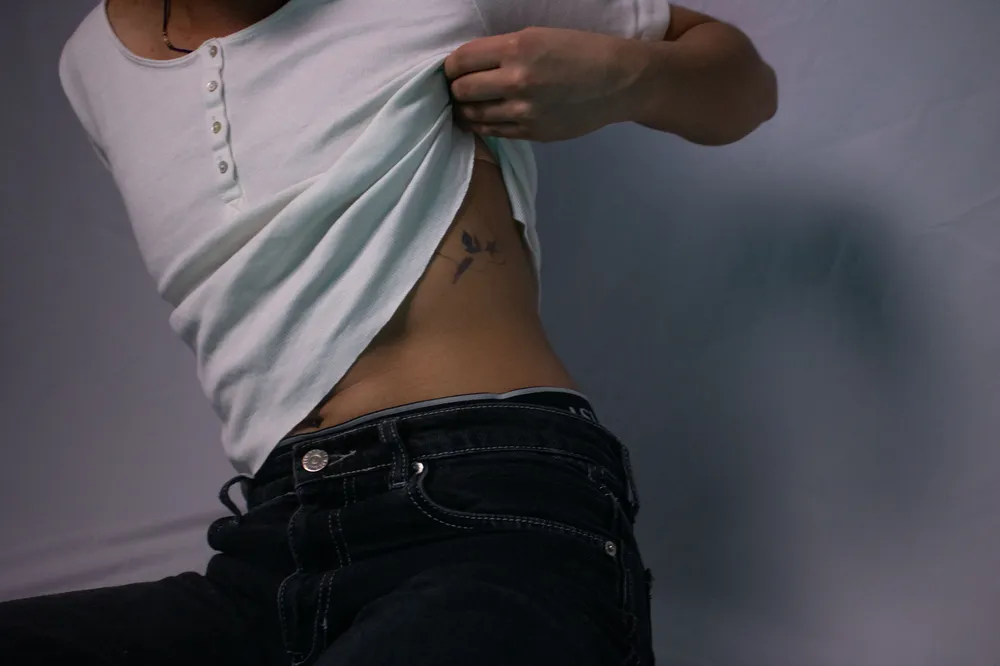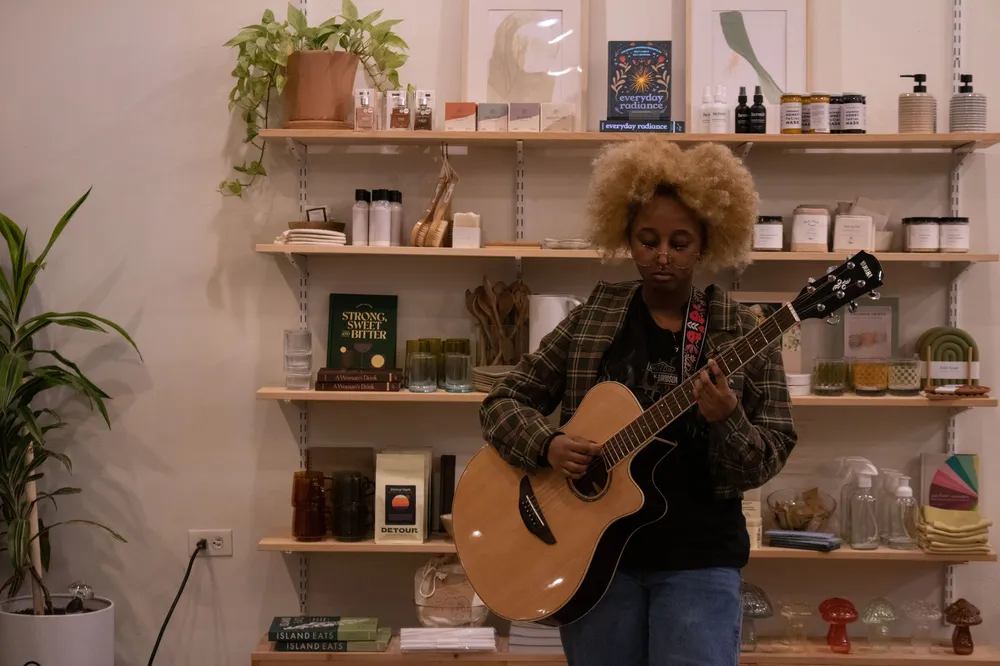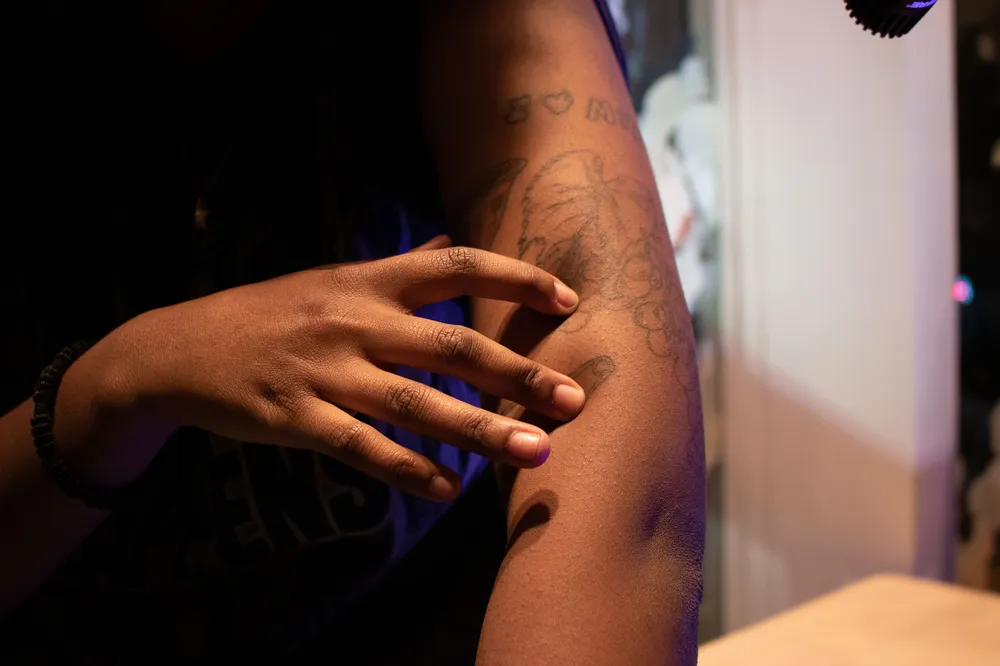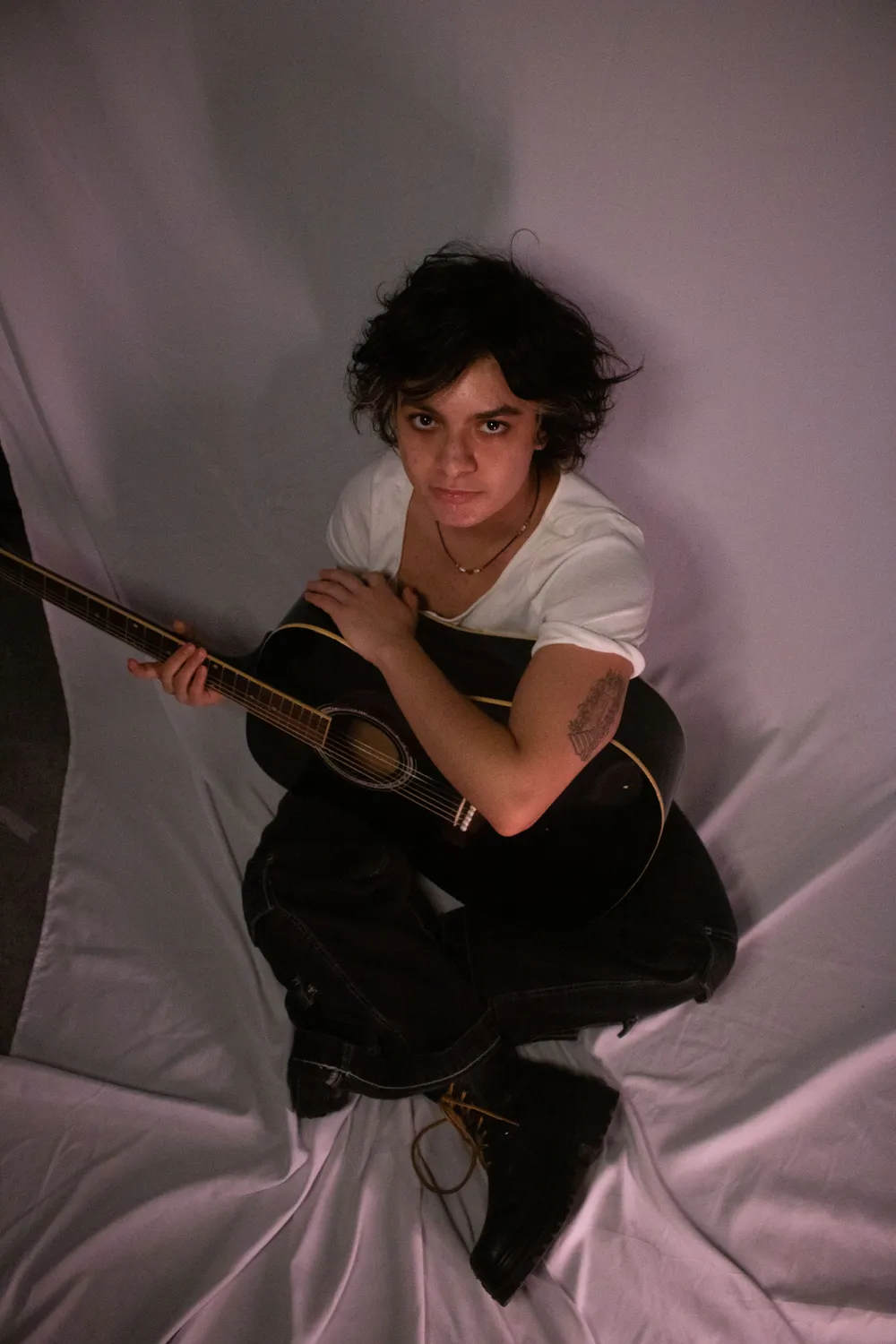When the North American youth of the late ‘60s were struck with the bleakness of industrialization, the uproaring renaissance of punk and rock followed. Those movements inextricably linked the music and tattoo scenes.
Body adornment was adopted as a way of claiming agency and rejecting mainstream society — including the art that people looked toward.
Like ripples, this mentality folded into the context of Vancouver’s underground music scene.
“I remember being 13 and emo,” said local musician Haleluya Hailu. “I very much looked up to a lot of people from alternative subcultures who were like, ‘I don’t really care what a person is supposed to necessarily look like, I just want to express myself in a way that feels fun.’”
Emerson Landwehr, a musician and second-year psychology student at UBC, has a colourful free-flowing tattoo parsed into three sections that runs down their torso to their leg. When an artist they admired took up residency in Vancouver, Landwehr took the opportunity to collaborate on the design.
“You know when kids are drawing stuff, they just go for it and they just draw things and it’s not restricted by all of the different norms that we’ve already learned by the time we’ve become adults?” they said. “It kind of felt like that, except it was obviously ... intentional.”
‘All art is expression’
Hailu isn’t bothered that they share the same ‘I heart music’ flash tattoo with other people. Flash tattoos are pre-drawn, ready-to-go designs that an artist offers. The group of strangers all decided to get this ink design, sharing a “human experience” at Music Waste — a cheeky local annual music festival that was born “as a sort of protest against the more corporate and exclusive Music West festival,” according to Music Waste’s website.
“I think it’s just such a funny [tattoo] because it was just such a spur of the moment [decision],” Hailu added.
Like photos in a scrapbook, Hailu said each tattoo is associated with a memory and “are super intimate,” they said.
Getting something marked on your skin forever is a big commitment. But that doesn’t bother Landwehr — they enjoy having a visible reminder of who they were and what they liked at different points in their life.
Each of their tattoos include elements that Landwehr designed themselves, which adds another layer of meaning and intentionality to them. The constant presence of the tattoos is helpful while they’re on a stage or in the technicolour crowds of a local venue, where it can be hard to express their feelings.
“It does take a lot of vulnerability to play music or to show your art in some way,” Landwehr admitted.
“[Performing is] a scary thing for a lot of people, but if you’re in an environment where everyone is doing that very openly, and sharing these very vulnerable pieces of who they are, it becomes a lot easier to see other people as human beings.”
Local musical spaces like Music Waste nourish connection and demonstrations of craft.
Landwehr recalled a series of get-togethers some UBC students hosted last summer that served as an artist marketplace and a safe space to share local crafts.
“There was always a little area where people were getting tattoos or doing tattoos,” Landwehr said. “And there was always also some people doing improvisational music of some kind, and I also improvised with some people there a couple times.”
Not only were there a variety of art forms to engage with — people often jumped between them. After playing a set, someone might head over to their tattoo station to do some flash pieces.
Landwehr got most of their tattoos in the early stages of their involvement in Vancouver’s music scene.
“All art is expression in some way,” they said. “If you have multiple mediums of art, I think it’s easy to, once you get very invested in one of them ... also have that creatively influence other things, and it can create a sort of feedback loop.”
It’s a cycle where tattoos are proof of choice, a mosaic canvas of memories and a venture into discomfort.
“I’m so much more open to this idea of experiencing everything good and bad and dirty, and tattoos are a part of that,” Hailu said. “It’s a little bit uncomfortable. But you’re left with this amazing piece of art at the end and I feel that reflects on my music.”
“I think you’re a lot cooler of a person if you do push yourself to do something that might be a little bit uncomfortable.”
The tattoo ceiling in classical music
Due to their origin as a form of rebellion, tattoos are still taboo in some spaces, particularly in the workplace. However, many are gradually learning to accept — or even encourage — these displays of creative expression, especially in the indie music scene.
But this mindset change is taking longer to unfold in more traditional art forms.
“In the classical music world, there’s definitely still that element of uncertainty,” said Dr. Robert Komaniecki, a UBC music theory lecturer.
“If a student is an opera singer, and they want to pursue a career in opera, there is hesitation about getting visible tattoos because if you are performing ...and the opera is set in the time it was composed, then people might not want you to have a big lizard tattooed on your forearm.”
Though perceptions are changing in the classical music industry as more people look to express themselves through body art, tattoo placement is still a consideration classical musicians take into account when compared to their alternative cousins.
“People are worried about making themselves a liability to be employed,” Komaniecki said.
Third-year vocal performance student Sofia Culjak-Wade was conscious of where she decided to place her first tattoo — a custom design of the star tarot card signifying hope. One of her concerns was that if it was in a highly visible spot like her arms, it might impact the way she’s perceived during auditions, and she’d be forced to cover it up while singing.
“Even though things are a lot more progressive now, you don’t know who is casting,” said Culjak-Wade. ”You don’t know who’s behind that desk, and just on the off chance that maybe it might affect how the outcome of your audition goes, because competition is high for roles, people cover it up.”
But as opera explores edgier tangents, it seems possible that the industry’s perceptions might evolve to allow for more expression — or at the very least, more willingness to accept tattooed singers under the condition that they hide their body art.
“I love tattoos,” said Culjak-Wade. “I love seeing tattoos on people and what people get."
“If the singer is okay to put makeup on or wear longer sleeves, then it’s nothing that can’t be fixed by costuming if you do want a more traditional look — by all means, singers, go crazy.”
The replication crisis
Music in all its genres and forms isn’t perfectly replicable. Each performance sounds a little different, every song has its nuances and all artists have their own little quirks.
Landwehr doesn’t quite know how to place their musical style, but believes it could best fit under something like jazz. To them, it’s not a genre as much as it is “an umbrella term for a bunch of different stuff that stems from the same underlying systems in some ways.”
Similar to music, Landwehr views their tattoos and the meaning behind them as a mosaic.
“I’m not sure if I can always describe what it means to me emotionally,” they said. “I don’t think it necessarily has to have any meaning for me past [being] something that I’ve chosen intentionally and that in some way represents a period of my life. I’m happy with the fact that [it’s] something I can always access wherever I am.”
Having music as an outlet to mess around with under low stakes molds a transient self-identity and style, but it’s nice to have something like a tattoo that stays constant.
“Tattoos are kind of the polar opposite [of music] ... one can be that very permanent form of expression, the other isn’t,” Landwehr said. “I think people like having a combination of the two — they balance each other out.”
— with files from Jocelyn Baker




